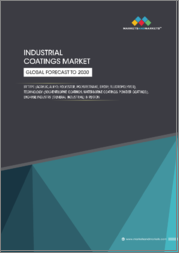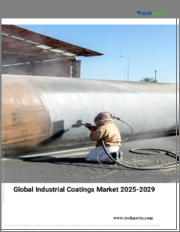
|
시장보고서
상품코드
1675395
산업용 코팅 시장 : 제품별, 기술별, 최종사용자별, 지역별(2025-2033년)Industrial Coatings Market by Product, Technology, End User, and Region 2025-2033 |
||||||
세계의 산업용 코팅 시장 규모는 2024년에 1,162억 달러에 달했습니다. 향후 IMARC Group은 시장이 2033년까지 1,462억 달러에 달하며, 2025-2033년에 2.45%의 성장률(CAGR)을 보일 것으로 예측하고 있습니다. 환경의 지속가능성에 관한 개인 및 기업의 의식 향상, 헬스케어 산업에서 항균 특성을 가진 코팅의 사용 증가, 디지털화와 스마트 코팅으로의 이동 증가는 시장을 추진하는 주요 요인의 일부입니다.
산업용 코팅은 보호, 미관 개선, 성능 강화를 목적으로 제조 및 산업 현장의 다양한 표면에 도포됩니다. 에폭시 도료, 폴리우레탄 도료, 분체 도료, 내식성 도료 등이 있습니다. 이러한 도료는 가혹한 환경 조건, 화학물질, 부식, 마모에 견딜 수 있도록 배합되어 있습니다. 하부 소재와 습기, 화학물질과 같은 부식성 요소 사이에 장벽을 만들어 녹과 열화를 방지합니다. 자동차, 제조업 등 수많은 산업에서 설비, 구조물, 제품의 수명과 기능성을 유지하는데 도움을 주고 있습니다.
세계의 급속한 도시화와 인프라 프로젝트는 건물, 교량 및 기타 구조물을 환경적 요소와 마모로부터 보호하는 코팅에 대한 수요를 불러일으키고 있습니다. 또한 특히 병원 및 의료 시설에서 위생적인 표면을 유지하기 위해 의료 산업에서 항균 특성을 가진 코팅의 사용이 증가함에 따라 시장 성장이 강화되고 있습니다. 이와는 별도로 풍력 터빈 및 태양전지판과 같은 재생 에너지 원의 성장은 성능, 내구성 및 내후성을 향상시키기 위한 특수 코팅에 대한 수요를 촉진하고 있습니다. 또한 해양 분야에서는 방오, 방청, 방청, 마찰 감소, 연비 향상 등의 목적으로 도료가 널리 사용되고 있으며, 시장 성장을 가속하고 있습니다.
산업용 코팅 시장 동향/촉진요인:
환경 규제와 지속가능성
환경 지속가능성에 대한 개인과 기업의 인식이 높아지는 것은 시장 성장을 지원하는 주요 요인 중 하나입니다. 이와는 별도로, 지속가능하고 친환경적인 제품에 대한 수요가 증가함에 따라 제조업체들이 보다 친환경적인 관행을 채택하도록 장려하고 있습니다. 또한 기업은 고성능을 유지하면서 환경에 미치는 영향을 줄인 코팅을 개발하기 위해 연구개발에 투자하고 있습니다. 또한 각국 당국과 국제기구는 페인트에 사용되는 휘발성 유기화합물(VOC)과 유해 화학물질에 대한 규제를 강화하고 있습니다. 이에 따라 전 세계 지속가능성 목표에 부합하는 친환경 저 VOC 수성 도료의 개발이 진행되고 있습니다.
첨단 기술 통합
산업용 코팅에 나노테크놀러지의 통합도 시장 성장을 지원하는 주요 요인입니다. 나노코팅은 나노 크기의 입자를 조작하여 경도, 스크래치 저항, 내식성 및 기타 특성을 향상시킵니다. 이와는 별도로, 다양한 산업 분야에서 우수한 보호 성능과 내구성을 제공하는 코팅에 대한 수요가 증가함에 따라 시장 성장을 가속하고 있습니다. 또한 나노코팅은 얇고 가벼우면서도 매우 효과적인 보호 층을 제공할 수 있으므로 자동차, 항공우주 및 전자 산업에서 사용이 증가하고 있으며, 이는 세계 수요의 원동력이 되고 있습니다. 또한 의료 및 식품 가공 분야에서 이러한 코팅이 널리 채택되고 있는 것도 시장에 긍정적인 영향을 미치고 있습니다.
디지털화 및 스마트 코팅
인더스트리 4.0과 사물인터넷(IoT)에 힘입어 디지털화와 스마트 코팅으로의 전환이 가속화되면서 시장을 주도하고 있습니다. 스마트 코팅은 온도, 빛, 수분 등의 외부 자극에 반응하여 그에 따라 특성을 변화시키도록 설계되어 있습니다. 또한 항공우주 분야에서는 구조적 손상을 감지하고 항공기 상태에 대한 실시간 피드백을 제공하기 위해 이러한 코팅의 사용이 증가하고 있으며, 이는 세계 수요의 원동력이 되고 있습니다. 이와는 별도로, 자동차 산업에서는 작은 흠집이나 손상을 복구하는 자가 복구 코팅의 채택이 증가하고 있으며, 이는 시장 성장을 가속하고 있습니다. 또한 센서와 데이터 수집 기능을 코팅에 통합하여 원격 모니터링 및 예측 유지보수를 가능하게 하여 가동 중지 시간과 운영 비용을 절감할 수 있습니다.
목차
제1장 서문
제2장 조사 범위와 조사 방법
- 조사의 목적
- 이해관계자
- 데이터 소스
- 1차 정보
- 2차 정보
- 시장 추정
- 보텀업 어프로치
- 톱다운 어프로치
- 조사 방법
제3장 개요
제4장 서론
- 개요
- 주요 업계 동향
제5장 세계의 산업용 코팅 시장
- 시장 개요
- 시장 실적
- COVID-19의 영향
- 시장 예측
제6장 시장 내역 : 제품별
- 아크릴
- 알키드
- 폴리우레탄
- 에폭시
- 폴리에스테르
- 기타
제7장 시장 내역 : 기술별
- 용제계
- 수성계
- 분말계
- 기타
제8장 시장 내역 : 최종사용자별
- 일반 산업
- 선박
- 자동차·차량 보수
- 일렉트로닉스
- 항공우주
- 석유 및 가스
- 광업
- 발전
- 기타
제9장 시장 내역 : 지역별
- 북미
- 미국
- 캐나다
- 아시아태평양
- 중국
- 일본
- 인도
- 한국
- 호주
- 인도네시아
- 기타
- 유럽
- 독일
- 프랑스
- 영국
- 이탈리아
- 스페인
- 러시아
- 기타
- 라틴아메리카
- 브라질
- 멕시코
- 기타
- 중동 및 아프리카
- 시장 내역 : 국가별
제10장 촉진요인·억제요인·기회
- 개요
- 촉진요인
- 억제요인
- 기회
제11장 밸류체인 분석
제12장 Porter's Five Forces 분석
- 개요
- 바이어의 교섭력
- 공급 기업의 교섭력
- 경쟁의 정도
- 신규 진출업체의 위협
- 대체품의 위협
제13장 가격 분석
제14장 경쟁 구도
- 시장 구조
- 주요 기업
- 주요 기업의 개요
- Akzo Nobel N.V.
- Axalta Coating Systems Ltd.
- BASF SE
- Chugoku Marine Paints Ltd.
- Hempel A/S
- Jotun
- Kansai Paint Co. Ltd.
- Nippon Paint Holdings Co., Ltd
- PPG Industries Inc.
- The Sherwin-Williams Company
- Wacker Chemie AG
The global industrial coatings market size reached USD 116.2 Billion in 2024. Looking forward, IMARC Group expects the market to reach USD 146.2 Billion by 2033, exhibiting a growth rate (CAGR) of 2.45% during 2025-2033. The rising awareness among individuals and companies about environmental sustainability, increasing use of coatings with antimicrobial properties in the healthcare industry, and the rising shift toward digitalization and smart coatings are some of the major factors propelling the market.
Industrial coatings are applied to various surfaces in manufacturing and industrial settings to provide protection, improve aesthetics, and enhance performance. They include epoxy, polyurethane, powder, and corrosion-resistant coatings. They are formulated to withstand harsh environmental conditions, chemicals, corrosion, and wear and tear. They create a barrier between the underlying material and corrosive elements like moisture and chemicals, preventing rust and deterioration. They help in preserving the longevity and functionality of equipment, structures, and products across numerous industries, such as automotive and manufacturing.
Rapid urbanization and infrastructure projects worldwide are catalyzing the demand for coatings to protect buildings, bridges, and other structures from environmental elements and wear. Additionally, the increasing use of coatings with antimicrobial properties in the healthcare industry to maintain hygienic surfaces, particularly in hospitals and healthcare facilities is strengthening the growth of the market. Apart from this, the growth of renewable energy sources, such as wind turbines and solar panels, is driving the demand for specialized coatings to enhance performance, durability, and weather resistance. Furthermore, the widespread utilization of coatings in the marine sector for anti-fouling and anti-corrosion purposes and reducing friction and enhancing fuel efficiency is propelling the market growth.
Industrial Coatings Market Trends/Drivers:
Environmental regulations and sustainability
The rising awareness among individuals and companies about environmental sustainability represents one of the major factors supporting the market growth. Apart from this, the escalating demand for sustainable and environment friendly products is encouraging manufacturers to adopt greener practices. Additionally, companies are investing in research and development to create coatings with reduced environmental impact while maintaining high performance. Furthermore, governing authorities of various countries and international organizations are imposing stricter regulations on volatile organic compounds (VOCs) and hazardous chemicals used in coatings. This is leading to the development of eco-friendly, low-VOC, and water-based coatings, aligning with global sustainability goals.
Integration of advanced technologies
The integration of nanotechnology into industrial coatings is another major factor supporting the market growth. Nanocoatings involve the manipulation of particles at the nanoscale to enhance properties like hardness, scratch resistance, and anti-corrosion performance. Apart from this, the rising demand for coatings that offer superior protection and durability across different industry verticals is favoring the market growth. Furthermore, the increasing use of nanocoatings in automotive, aerospace, and electronics industries due to their ability to provide thin, lightweight, and highly effective protective layers is driving their demand globally. Moreover, the widespread adoption of these coatings in healthcare and food processing is positively influencing the market.
Digitalization and smart coatings
The rising shift toward digitalization and smart coatings, driven by Industry 4.0 and the Internet of Things (IoT) is driving the market. Smart coatings are engineered to respond to external stimuli, such as temperature, light, or moisture, and adapt their properties accordingly. Additionally, the increasing utilization of these coatings in the aerospace sector to detect structural damage and provide real-time feedback on the condition of aircraft is driving their demand across the globe. Apart from this, the rising adoption of self-healing coatings that repair minor scratches and damages in the automotive industry is favoring the market growth. Furthermore, the integration of sensors and data collection capabilities into coatings allows for remote monitoring and predictive maintenance, reducing downtime and operational costs.
Industrial Coatings Industry Segmentation:
Breakup by Product:
- Acrylic
- Alkyd
- Polyurethane
- Epoxy
- Polyester
- Others
Acrylic dominates the market
Breakup by Technology:
- Solvent Borne
- Water Borne
- Powder Based
- Others
Solvent-borne holds the largest market share
Breakup by End User:
- General Industrial
- Marine
- Automotive and Vehicle Refinish
- Electronics
- Aerospace
- Oil and Gas
- Mining
- Power Generation
- Others
General industrial accounts for the majority of the market share
Breakup by Region:
- North America
- United States
- Canada
- Asia Pacific
- China
- Japan
- India
- South Korea
- Australia
- Indonesia
- Others
- Europe
- Germany
- France
- United Kingdom
- Italy
- Spain
- Russia
- Others
- Latin America
- Brazil
- Mexico
- Others
- Middle East and Africa
Asia Pacific exhibits a clear dominance, accounting for the largest industrial coatings market share
The market research report has also provided a comprehensive analysis of all the major regional markets, which include North America (the United States and Canada); Europe (Germany, France, the United Kingdom, Italy, Spain, Russia, and others); Asia Pacific (China, Japan, India, South Korea, Australia, Indonesia, and others); Latin America (Brazil, Mexico, and others); and the Middle East and Africa. According to the report, Asia Pacific accounted for the largest market share due to the presence of various industries in the region. Additionally, the large population in the Asia-Pacific creates a high demand for consumer goods, which indirectly drives the demand for industrial coatings. Apart from this, countries like China and India are significant manufacturing hubs, which require vast amounts of industrial coatings for machinery, equipment, and buildings. Furthermore, the availability of skilled labor for the application of industrial coatings is another contributing factor. Moreover, increasing investment in infrastructure projects in the region is driving the demand for protective and specialized coatings.
Competitive Landscape:
Companies are continuously investing in R&D to develop innovative coatings that offer enhanced performance, durability, and environmental sustainability. They are focusing on innovating formulations that provide better corrosion resistance, UV protection, and resistance to chemicals and abrasion. Additionally, many companies are focusing on developing eco-friendly coatings with low volatile organic compounds (VOCs) and reduced environmental impact. Apart from this, they are actively engaged in marketing and promotional activities to reach potential clients and establish themselves as trusted providers. Moreover, they are implementing rigorous quality control processes to maintain consistency and reliability in their coatings. Furthermore, they are expanding their manufacturing and distribution capabilities to reach a broader market.
The report has provided a comprehensive analysis of the competitive landscape in the market. Detailed profiles of all major companies have also been provided. Some of the key players in the market include:
- Akzo Nobel N.V.
- Axalta Coating Systems Ltd.
- BASF SE
- Chugoku Marine Paints Ltd.
- Hempel A/S, Jotun
- Jotun
- Kansai Paint Co. Ltd.
- Nippon Paint Holdings Co., Ltd.
- PPG Industries Inc.
- The Sherwin-Williams Company
- Wacker Chemie AG
Key Questions Answered in This Report:
- How has the global industrial coatings market performed so far, and how will it perform in the coming years?
- What are the drivers, restraints, and opportunities in the global industrial coatings market?
- What is the impact of each driver, restraint, and opportunity on the global industrial coatings market?
- What are the key regional markets?
- Which countries represent the most attractive industrial coatings market?
- What is the breakup of the market based on the product?
- Which is the most attractive product in the industrial coatings market?
- What is the breakup of the market based on the technology?
- Which is the most attractive technology in the industrial coatings market?
- What is the breakup of the market based on the end user?
- Which is the most attractive end user in the industrial coatings market?
- What is the competitive structure of the global industrial coatings market?
- Who are the key players/companies in the global industrial coatings market?
Table of Contents
1 Preface
2 Scope and Methodology
- 2.1 Objectives of the Study
- 2.2 Stakeholders
- 2.3 Data Sources
- 2.3.1 Primary Sources
- 2.3.2 Secondary Sources
- 2.4 Market Estimation
- 2.4.1 Bottom-Up Approach
- 2.4.2 Top-Down Approach
- 2.5 Forecasting Methodology
3 Executive Summary
4 Introduction
- 4.1 Overview
- 4.2 Key Industry Trends
5 Global Industrial Coatings Market
- 5.1 Market Overview
- 5.2 Market Performance
- 5.3 Impact of COVID-19
- 5.4 Market Forecast
6 Market Breakup by Product
- 6.1 Acrylic
- 6.1.1 Market Trends
- 6.1.2 Market Forecast
- 6.2 Alkyd
- 6.2.1 Market Trends
- 6.2.2 Market Forecast
- 6.3 Polyurethane
- 6.3.1 Market Trends
- 6.3.2 Market Forecast
- 6.4 Epoxy
- 6.4.1 Market Trends
- 6.4.2 Market Forecast
- 6.5 Polyester
- 6.5.1 Market Trends
- 6.5.2 Market Forecast
- 6.6 Others
- 6.6.1 Market Trends
- 6.6.2 Market Forecast
7 Market Breakup by Technology
- 7.1 Solvent Borne
- 7.1.1 Market Trends
- 7.1.2 Market Forecast
- 7.2 Water Borne
- 7.2.1 Market Trends
- 7.2.2 Market Forecast
- 7.3 Powder Based
- 7.3.1 Market Trends
- 7.3.2 Market Forecast
- 7.4 Others
- 7.4.1 Market Trends
- 7.4.2 Market Forecast
8 Market Breakup by End User
- 8.1 General Industrial
- 8.1.1 Market Trends
- 8.1.2 Market Forecast
- 8.2 Marine
- 8.2.1 Market Trends
- 8.2.2 Market Forecast
- 8.3 Automotive and Vehicle Refinish
- 8.3.1 Market Trends
- 8.3.2 Market Forecast
- 8.4 Electronics
- 8.4.1 Market Trends
- 8.4.2 Market Forecast
- 8.5 Aerospace
- 8.5.1 Market Trends
- 8.5.2 Market Forecast
- 8.6 Oil and Gas
- 8.6.1 Market Trends
- 8.6.2 Market Forecast
- 8.7 Mining
- 8.7.1 Market Trends
- 8.7.2 Market Forecast
- 8.8 Power Generation
- 8.8.1 Market Trends
- 8.8.2 Market Forecast
- 8.9 Others
- 8.9.1 Market Trends
- 8.9.2 Market Forecast
9 Market Breakup by Region
- 9.1 North America
- 9.1.1 United States
- 9.1.1.1 Market Trends
- 9.1.1.2 Market Forecast
- 9.1.2 Canada
- 9.1.2.1 Market Trends
- 9.1.2.2 Market Forecast
- 9.1.1 United States
- 9.2 Asia-Pacific
- 9.2.1 China
- 9.2.1.1 Market Trends
- 9.2.1.2 Market Forecast
- 9.2.2 Japan
- 9.2.2.1 Market Trends
- 9.2.2.2 Market Forecast
- 9.2.3 India
- 9.2.3.1 Market Trends
- 9.2.3.2 Market Forecast
- 9.2.4 South Korea
- 9.2.4.1 Market Trends
- 9.2.4.2 Market Forecast
- 9.2.5 Australia
- 9.2.5.1 Market Trends
- 9.2.5.2 Market Forecast
- 9.2.6 Indonesia
- 9.2.6.1 Market Trends
- 9.2.6.2 Market Forecast
- 9.2.7 Others
- 9.2.7.1 Market Trends
- 9.2.7.2 Market Forecast
- 9.2.1 China
- 9.3 Europe
- 9.3.1 Germany
- 9.3.1.1 Market Trends
- 9.3.1.2 Market Forecast
- 9.3.2 France
- 9.3.2.1 Market Trends
- 9.3.2.2 Market Forecast
- 9.3.3 United Kingdom
- 9.3.3.1 Market Trends
- 9.3.3.2 Market Forecast
- 9.3.4 Italy
- 9.3.4.1 Market Trends
- 9.3.4.2 Market Forecast
- 9.3.5 Spain
- 9.3.5.1 Market Trends
- 9.3.5.2 Market Forecast
- 9.3.6 Russia
- 9.3.6.1 Market Trends
- 9.3.6.2 Market Forecast
- 9.3.7 Others
- 9.3.7.1 Market Trends
- 9.3.7.2 Market Forecast
- 9.3.1 Germany
- 9.4 Latin America
- 9.4.1 Brazil
- 9.4.1.1 Market Trends
- 9.4.1.2 Market Forecast
- 9.4.2 Mexico
- 9.4.2.1 Market Trends
- 9.4.2.2 Market Forecast
- 9.4.3 Others
- 9.4.3.1 Market Trends
- 9.4.3.2 Market Forecast
- 9.4.1 Brazil
- 9.5 Middle East and Africa
- 9.5.1 Market Trends
- 9.5.2 Market Breakup by Country
- 9.5.3 Market Forecast
10 Drivers, Restraints, and Opportunities
- 10.1 Overview
- 10.2 Drivers
- 10.3 Restraints
- 10.4 Opportunities
11 Value Chain Analysis
12 Porters Five Forces Analysis
- 12.1 Overview
- 12.2 Bargaining Power of Buyers
- 12.3 Bargaining Power of Suppliers
- 12.4 Degree of Competition
- 12.5 Threat of New Entrants
- 12.6 Threat of Substitutes
13 Price Analysis
14 Competitive Landscape
- 14.1 Market Structure
- 14.2 Key Players
- 14.3 Profiles of Key Players
- 14.3.1 Akzo Nobel N.V.
- 14.3.1.1 Company Overview
- 14.3.1.2 Product Portfolio
- 14.3.1.3 Financials
- 14.3.1.4 SWOT Analysis
- 14.3.2 Axalta Coating Systems Ltd.
- 14.3.2.1 Company Overview
- 14.3.2.2 Product Portfolio
- 14.3.2.3 Financials
- 14.3.2.4 SWOT Analysis
- 14.3.3 BASF SE
- 14.3.3.1 Company Overview
- 14.3.3.2 Product Portfolio
- 14.3.3.3 Financials
- 14.3.3.4 SWOT Analysis
- 14.3.4 Chugoku Marine Paints Ltd.
- 14.3.4.1 Company Overview
- 14.3.4.2 Product Portfolio
- 14.3.4.3 Financials
- 14.3.4.4 SWOT Analysis
- 14.3.5 Hempel A/S
- 14.3.5.1 Company Overview
- 14.3.5.2 Product Portfolio
- 14.3.5.3 SWOT Analysis
- 14.3.6 Jotun
- 14.3.6.1 Company Overview
- 14.3.6.2 Product Portfolio
- 14.3.6.3 SWOT Analysis
- 14.3.7 Kansai Paint Co. Ltd.
- 14.3.7.1 Company Overview
- 14.3.7.2 Product Portfolio
- 14.3.7.3 Financials
- 14.3.7.4 SWOT Analysis
- 14.3.8 Nippon Paint Holdings Co., Ltd
- 14.3.8.1 Company Overview
- 14.3.8.2 Product Portfolio
- 14.3.8.3 Financials
- 14.3.8.4 SWOT Analysis
- 14.3.9 PPG Industries Inc.
- 14.3.9.1 Company Overview
- 14.3.9.2 Product Portfolio
- 14.3.9.3 Financials
- 14.3.9.4 SWOT Analysis
- 14.3.10 The Sherwin-Williams Company
- 14.3.10.1 Company Overview
- 14.3.10.2 Product Portfolio
- 14.3.10.3 Financials
- 14.3.10.4 SWOT Analysis
- 14.3.11 Wacker Chemie AG
- 14.3.11.1 Company Overview
- 14.3.11.2 Product Portfolio
- 14.3.11.3 Financials
- 14.3.11.4 SWOT Analysis
- 14.3.1 Akzo Nobel N.V.
Kindly note that this only represents a partial list of companies, and the complete list has been provided in the report.



















